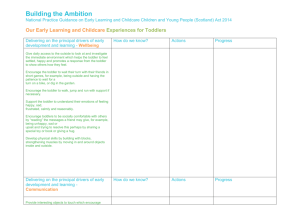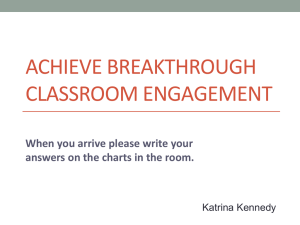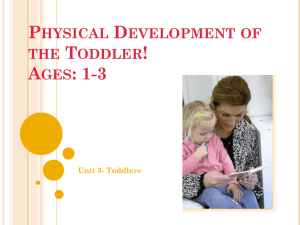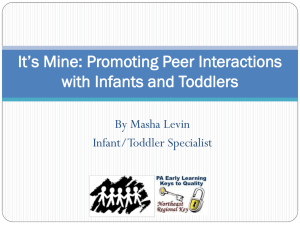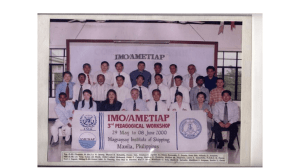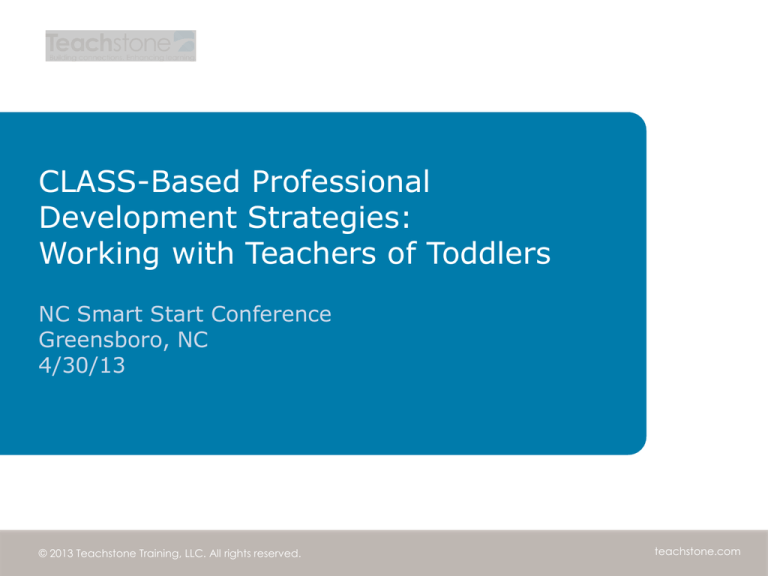
CLASS-Based Professional
Development Strategies:
Working with Teachers of Toddlers
NC Smart Start Conference
Greensboro, NC
4/30/13
© 2013 Teachstone Training, LLC. All rights reserved.
teachstone.com
Objectives
• Gain an overview of toddler development
• Increase understanding of the Toddler Classroom
Assessment Scoring System™ (CLASS™)
• Increase understanding of effective professional
development practices
• Experience CLASS-based approaches for
supporting teachers of toddlers
Getting to Know You
• How do you work with toddler teachers?
– Role?
– Strategies used?
• How familiar are you with the Toddler
CLASS measure?
Context
Issues facing toddler teachers
• Toddlers change rapidly
• Toddlers are dependent on adults
• Teachers may come from preschool classrooms
• Education is often focused on preschoolers
Overview of Toddler
Development
Defining Toddlers
• 15 to 36 months old
• Exponential growth
• Varying rates of
development
• Emerging sense of
identity and autonomy
• Dependent on adults
• Active learners
Toddler Development
Whole child
•
•
•
•
Physical
Language
Cognitive
Social/Emotional
Toddler CLASS Measure
Elements of Classrooms
Influencing Learning
STRUCTURE
PROCESS
What? Who? Where?
How?
Curriculum
Implementation
Standards
Relationships
Materials
Social and Academic
Interactions
Training and Education
Children’s Cognitive
and
Social Development
Effective Interactions
Classroom Interactions
Emotional and
Behavioral
Support
Engaged
Support for
Learning
Toddler CLASS Structure
DOMAIN
Emotional and
Behavioral
Support
Positive Climate
DIMENSION
Engaged Support
for Learning
Negative Climate
Facilitation of Learning and
Development
Teacher Sensitivity
Quality of Feedback
Regard for Child Perspectives
Language Modeling
Behavior Guidance
Example –
INDICATOR
Positive Climate:
Relationships
Positive affect
Respect
BEHAVIORAL
MARKER
Example –
Relationships: physical
proximity, matched positive
affect
Example –
Facilitation of Learning and
Development:
Active facilitation
Expansion of cognition
Children’s active engagement
Example –
Active facilitation: teacher
provides opportunities for
exploration
Emotional and Behavioral Support
Domain
Teachers
Children develop
• Create a warm and
positive climate
• Supportive relationships
• Understand children’s
needs
• Respond sensitively
• Follow children’s interests
• Guide children socially
• Enjoyment
• A secure attachment base
• Increasing autonomy
• Self-regulation skills
Engaged Support for Learning Domain
Teachers
Children develop
• Provide learning
opportunities
• Connections
• Ask questions and add
information
• Use feedback
• Expand language skills
• Problem-solving and
thinking skills
• Increased attention,
engagement, and selfefficacy
• Receptive and expressive
language
In-Depth Review:
Engaged Support for Learning
Dimensions
Facilitation of Learning and
Development
Considers how well the
teacher facilitates
activities to support
children’s learning and
understanding
Facilitation of Learning and
Development Indicators
• Active Facilitation
• Expansion of Cognition
• Active Engagement (children)
Quality Of Feedback
Assesses the degree to
which the teacher
provides feedback (in
response to what
children say or do) that
promotes learning and
understanding and
expands children’s
participation
Quality Of Feedback Indicators
• Scaffolding
• Providing Information
• Encouragement and Affirmation
Language Modeling
Captures the quality
and amount of teachers’
use of languagestimulation and
language-facilitation
techniques to encourage
children’s language
development
Language Modeling Indicators
• Supporting Language Use
• Repetition and Extension
• Self- and Parallel Talk
• Advanced Language
Principles of Effective
Professional Development
Coaching Fundamentals
Principles of Effective
Professional Development
• Focused on teacher-child interactions
• Anchored in Teacher’s Actual Practice
• Based on Validated Framework
• Embedded in Relationships
• Delivered through a Standardized Process
Facilitating Teacher Discussion
• Detect
– Help teachers identify effective interactions
• Reflect
– Prompt teachers thinking about their own
practice (actual and possible)
• Connect
– Encourage teachers to connect their actions to
children’s learning and development
Detect
1. Think about the concepts,
connections, and
language that were/could
be taught within the
interaction.
2. Focus on positives, first
state what was observed
and what was done well.
3. If needed, break down
the components of the
interaction.
Reflect
4. Ask the teacher to reflect
upon their own classroom
experiences and
observations.
5. Using open-ended
questioning, prompt
teacher to discuss
underlying reasons,
brainstorm, or problemsolve.
Connect
6. Help the teacher to
connect teacher behaviors
with child outcomes.
7. Discuss ideas/plans for
future interactions.
8. When possible, use reallife classroom examples.
Video Practice: Facilitation of Learning
and Development
• Watch video: Slugs and Puppies, part 1
• Take notes on Facilitation of Learning and
Development indicators and behaviors
• Strengths and areas for improvement
Detect Questions
• What types of questions does the teacher
ask?
• What does the teacher say to connect
classroom concepts or activities?
• How does the teacher embed new
information in the activity?
Reflect Questions
• What are some benefits of asking openended questions?
• How might teachers help children make
connections across concepts or activities?
• What is the value of including information
within an activity?
Connect Questions
• How can you guide children’s exploration
and provide opportunities for learning?
• In what ways can you integrate concepts
and encourage children to make
connections?
Video Practice:
Quality of Feedback
• Watch video: Slugs and Puppies, part 2
• Take notes on
– Quality of Feedback indicators and behaviors
– Strengths and areas for improvement
Detect Questions
• Quality of Feedback occurs in response to
something children do or say. What does
the teacher respond to in this video?
• What hints or assistance does the teacher
provide to scaffold learning?
• What does the teacher say or do to
encourage or reinforce children’s efforts?
Reflect Questions
• Why is scaffolding better for children’s
learning than just completing the task for
the child?
• In what ways can teachers provide specific
feedback to individual children?
Connect Questions
• How can you provide hints to children
when they struggle with a task or activity?
• Share one or two specific strategies you
might consider implementing in your
classroom to enhance your feedback to
children.
Video Practice:
Language Modeling
• Watch video: Slugs and Puppies, part 3
• Take notes on Language Modeling
indicators and behaviors
• Strengths and areas for improvement
Detect Questions
• How does the teacher encourage children’s
use of language?
• How does the teacher repeat or expand
children’s responses?
• How does the teacher map actions with
language?
Reflect Questions
• What might be the difference between
repeating and extending?
• What are the benefits of including selfand parallel talk in the classroom?
Connect Questions
• How can you promote and sustain
teacher-child conversations in the
classroom?
• How can you use labeling and
conversation to introduce new words to
the children?
• Describe one or two specific steps you will
take to enhance the use of language in
your classroom.
Toddler CLASS Professional
Development
CLASS-Based Professional
Development Programs
CLASS-based programs vary in levels of intensity and focus.
Informational
Introduction
to the CLASS Tool
Improving
Practice
Video Library
Looking at
CLASSrooms
MyTeachingPartner™
Coaching
MyTeachingPartner™ Coaching
• Sustained focus on each
teacher’s unique needs
• One-on-one support
• Systematic, proven model
• Web-based, 24/7 access
MyTeachingPartner™ Coaching
MTP Coaching Cycle
Questions?
Stay in Touch with Us!
www.teachstone.com
www.facebook.com/Teachstone
Sedra Spano
sedra.spano@teachstone.com
Vicki Kintner-Duffy
vicki.kintner-duffy@teachstone.com
Jane McCarty
jane.mccarty@teachstone.com
https://twitter.com/Teachstone
Thank you!

